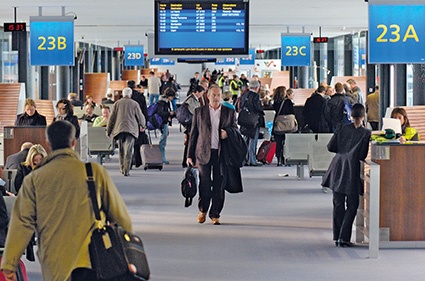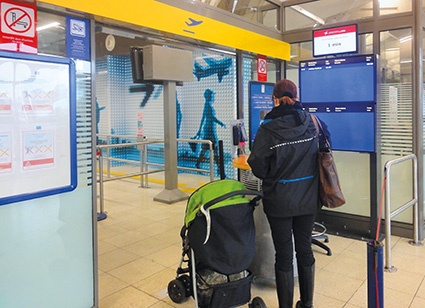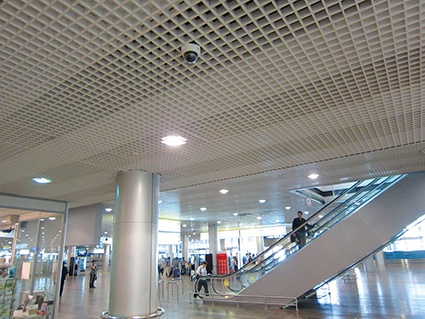Lifting the Airport Experience with Network Video
For a long time, video surveillance at airports was only a matter of security. Now, with the shift from analog to digital technology, numerous different airport operations can bene...



For a long time, video surveillance at airports was only a matter of security. Now, with the shift from analog to digital technology, numerous different airport operations can benefit from using network video cameras to improve daily operations, revenue opportunities and the overall passenger experience. Patrik Anderson, Director of Business Development, Transportation at Axis Communications explains.
It’s the distinct connection it makes with travelers – offering adventure, luxury, service, convenience and enjoyment – that sets an airport apart today. But making that connection requires an enormous, coordinated effort across every function of an airport. Using live and recorded video to help the different user groups with their day-to-day task of running the airport smoothly, video cameras are now also helping some airports to optimize luggage handling, to shorten check-in queues and to estimate the waiting times for passengers. It is the shift from analog to network cameras that has made this use of video for additional non-security applications possible.
Analog CCTV cameras sit in a closed system, whereas IP cameras are connected to an open network system and deliver the video images digitally over standard IP connections. This means different user groups can be given access to various parts of the live and/or recorded video stream from selected cameras. Based on their user rights, they can view video streams from any device that is connected to the network, making the video much more accessible. Being IP-based also allows the cameras to be integrated with other systems on the network, such as access control or smoke detection systems.
And, as the video is delivered in the form of digital data, it can be read and processed by intelligent software applications that can, for instance, automatically detect incidents such as a person entering a restricted area, a baggage jam or luggage falling off a conveyor belt. What‘s more, network cameras with built-in intelligence capabilities can not only send automatic alerts, but also provide analytics, such as traffic or passenger statistics – including numbers and flow patterns.
Flow Control
For example, at Sheremetyevo International Airport, Russia‘s largest and busiest airport with more than 26 million passengers each year, the video surveillance system serves not only as a security solution, but also as a means for controlling operations such as check-in, boarding, luggage loading control and other processes at all stages of aircraft servicing. The solution is neat as it simply uses the camera network that‘s already in place for security purposes. The IP cameras installed at the airport generate a single video stream, which is then processed by two systems – security and operational – according to the required tasks and algorithms.
One of the greatest benefits of network video is that it makes it possible to connect all cameras in an airport to one network. Being able to virtually place themselves at any location of the airport and see what is happening at any given time is essential to a number of user groups apart from airport security such as the police, customs, border control, flight services and even the airline companies. Live video from relevant areas provides each of these user groups with real-time information, helping them to make informed decisions fast to optimize performance and efficiency, such as by increasing staff levels or opening another check-in counter.
Situation Report
Tasks that previously required phone calls or manual checks can now be handled directly from a computer or even a mobile device. Munich airport in Germany already uses IP cameras to closely monitor aircraft servicing processes and simplify them. For example, ground and ramp services can use the cameras to establish whether a plane has docked at the gate, whether the baggage has been loaded, catering delivered and whether refueling is completed – all without having to physically go to the gate, make phone calls or use mobile radios.
Cameras can also help provide information to the control tower. Air traffic control can see how many planes are in the queue for a runway, whether lights on taxiways are working properly, and whether the runway is clear of snow and obstacles. In the long term, network cameras – gather with modern air traffic control systems and other computer-based systems that can be set up and run from any location – may even make traditional air traffic control towers redundant. Tests are ongoing with remote and virtual towers (RVT) for smaller airports in regions where the air traffic service can be centralized for efficiency.
Getting passengers to their gate in time to avoid flight delays is another key consideration. Shortening waiting times at check-in or security checks reduces passenger stress and boosts the overall passenger experience. Both can be achieved with a better understanding of passenger numbers and passenger flows, using cameras with a built-in people counting function. At Lyon‘s Saint Exupéry Airport in France, a network video system of close to 50 cameras is used to give passengers more information as they move around, including the estimated waiting times between security checkpoints and in departure lounges.
Concession Argumentation
Beyond improving operations, IP cameras are increasingly used in airport car parks and retail spaces. The aim is to provide a better passenger experience, but also to increase revenue opportunities. Denver International Airport in the US has installed a number of cameras that include optical character recognition to identify and store license plate numbers. When customers lose their parking tickets, attendants can quickly search the airport‘s data files by license plate number to determine when a specific vehicle entered the parking lot – a feature that helps prevent revenue loss.
Understanding customer statistics and conversion rates on the other hand is key to the retailers renting space at the airport. By offering surveillance as a service to airport concessions as part of the installed video camera network, as well as valuable footfall statistics, airports can generate additional revenue and add value for the retailers. The surveillance as a service model can also be extended to offer services to other tenants, such as airlines and freight companies.
Ultimately, using network video can help in running a more efficient and reliable airport: providing the right service to the right airplane at the right time, getting passengers and their luggage to where they need to be on time, avoiding flight delays and lost luggage, and opening up new business opportunities. As Frédéric Besson, Information Systems project leader, Aéroports de Lyon, puts it: “Beyond the satisfaction of the passengers that we achieve, we can see that the network video solution is a daily work tool that allows us to enhance our organization and assist our development.“
Business Partner
Axis Communications ABGränden 1
223 69 Lund
Sweden
most read

Integrated and Futureproof: Traka’s Next Chapter
Interview with Stefni Oliver on Traka’s Vision for the Future

GIT SECURITY AWARD 2026 - The winners have been announced!
GIT SECURITY AWARD 2026: The best safety and security solutions of the year - now an overview of all winners


When the Internet stumbles: Why DNS is important
When DNS fails, the internet stumbles-AWS outage proves resilience and redundancy are vital for digital trust

Assa Abloy's battery-powered Aperio KL100 secures lockers
Boost workplace security and operational flexibility by securing more than just doors.







